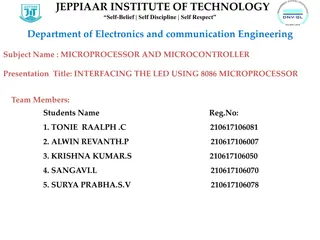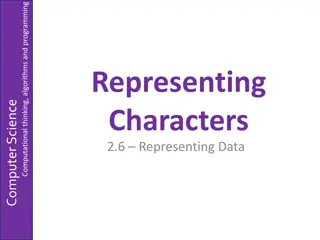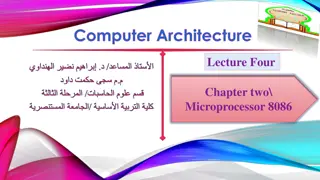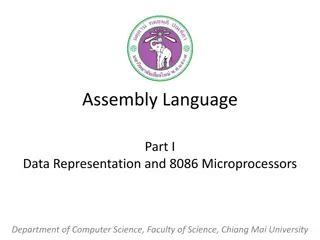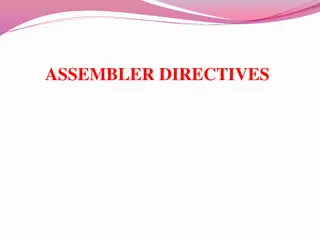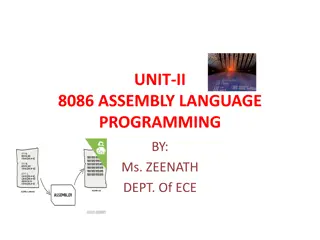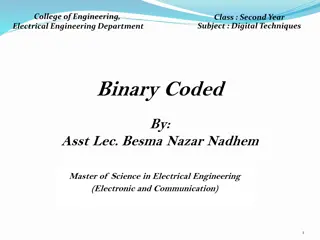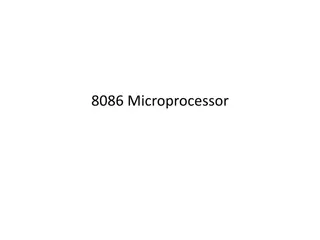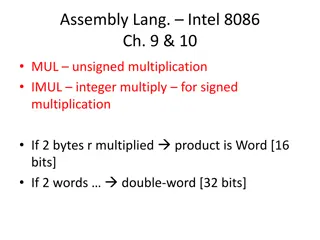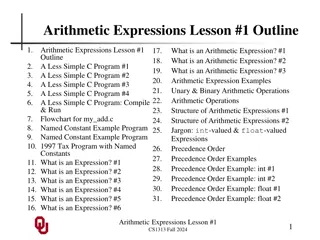Understanding BCD and ASCII Arithmetic in 8086 Assembly Language
BCD (Binary-Coded Decimal) and ASCII (American Standard Code for Information Interchange) are key concepts in 8086 assembly language for numerical and character manipulations. BCD Arithmetic involves addition and subtraction techniques using instructions like DAA and DAS. The adjustment instructions work with packed BCD data stored as two BCD digits per byte. The DAA instruction adjusts the result after addition, while the DAS instruction does so after subtraction. Examples illustrate how to perform BCD arithmetic operations and apply DAA and DAS instructions in programming scenarios.
Download Presentation

Please find below an Image/Link to download the presentation.
The content on the website is provided AS IS for your information and personal use only. It may not be sold, licensed, or shared on other websites without obtaining consent from the author. Download presentation by click this link. If you encounter any issues during the download, it is possible that the publisher has removed the file from their server.
E N D
Presentation Transcript
Topic BCD AND ASCII ARITHMETIC Presented by Mr. Bhushan S. Kulkarni Assistant Professor Department of Computer Science and IT. Deogiri College, Aurangabad
BCD AND ASCII ARITHMETIC BCD (binary-coded decimal) ASCII (American Standard Code for Information Interchange)Codes manipulations. 8086 allows this manipulations. This is accomplished by instructions that adjust the numbers for BCD and ASCII arithmetic.
BCD Arithmetic Two arithmetic techniques operate with BCD data: addition subtraction. DAA (decimal adjust after addition) DAS (decimal adjust after subtraction)
For BCD data, the numbers always appear in the packed BCD form. stored as two BCD digits per byte. The adjustment instructions function only with the AL register after BCD addition and subtraction.
DAA Instruction The DAA instruction follows the ADD or ADC instruction to adjust the result into a BCD result. Suppose that DX and BX each contain 4-digit packed BCD numbers. Example 5 18 provides a short sample program that adds the BCD numbers in DX and BX, and stores the result in CX.
Example MOV DX,1234H ;load 1234 BCD MOV BX,3099H ;load 3099 BCD MOV AL,BL ;sum BL and DL ADD AL,DL DAA MOV CL,AL ;answer to CL MOV AL,BH ;sum BH, DH and carry ADC AL,DH DAA MOV CH,AL ;answer to CH
Because the DAA instruction functions only with the AL register, this addition must occur 8 bits at a time. After adding the BL and DL registers, the result is adjusted with a DAA instruction before being stored in CL. Next, add BH and DH registers with carry; the result is then adjusted with DAA before being stored in CH. In this example, a 1234 is added to 3099 to generate a sum of 4333, which moves into CX after the addition. Note that 1234 BCD is the same as 1234H.
DAS Instruction. The DAS instruction functions as does the DAA instruction, except that it follows a subtraction instead of an addition. Example 5- 19 is the same as Example 5 18, except that it subtracts instead of adds DX and BX. The main difference in these programs is that the DAA instructions change to DAS, and the ADD and ADC instructions change to SUB and SBB instructions.
MOV DX,1234H ;load 1234 BCD MOV BX,3099H ;load 3099 BCD MOV AL,BL ;subtract DL from BL SUB AL,DL DAS MOV CL,AL ;answer to CL MOV AL,BH ;subtract DH SBB AL,DH DAS MOV CH,AL ;answer to CH
ASCII Arithmetic The ASCII arithmetic instructions function with ASCII-coded numbers. These numbers range in value from 30H to 39H for the numbers 0 9. There are four instructions used with ASCII arithmetic operations: AAA (ASCII adjust after addition), AAD (ASCII adjust before division), AAM (ASCII adjust after multiplication), and AAS (ASCII adjust after subtraction). These instructions use register AX as the source and as the destination.
AAA Instruction. The addition of two one-digit ASCII- coded numbers will not result in any useful data. For example, if 31H and 39H are added, the result is 6AH. This ASCII addition ( 9+1) should produce a two-digit ASCII result equivalent to a 10 decimal, which is a 31H and a 30H in ASCII code. If the AAA instruction is executed after this addition, the AX register will contain a 0100H. Although this is not ASCII code, it can be converted to ASCII code by adding 3030H to AX which generates 3130H. The AAA instruction clears AH if the result is less than 10, and adds 1 to AH if the result is greater than 10.
MOV AX,31H ;load ASCII 1 ADD AL,39H ;add ASCII 9 AAA ;adjust sum ADD AX,3030H ;answer to ASCII
Example 520 shows the way ASCII addition functions in the microprocessor. Please note that AH is cleared to zero before the addition by using the MOV AX,31H instruction. The operand of 0031H places 00H in AH and 31H into AL.
AAM Instruction. The AAM instruction follows the multiplication instruction after multiplying two one-digit unpacked BCD numbers. Example 5 22 shows a short program that multiplies 5 times 5. The result after the multiplication is 0019H in the AX register. After adjusting the result with the AAM instruction, AX contains 0205H. This is an unpacked BCD result of 25. If 3030H is added to 0205H, it has an ASCII result of 3235H.
MOV AL,5 ;load multiplicand MOV CL,3 ;load multiplier MUL CL AAM ;adjust
The AAM instruction accomplishes this conversion by dividing AX by 10. The remainder is found in AL, and the quotient is in AH. Note that the second byte of the instruction contains 0AH.
If the 0AH is changed to another value, AAM divides by the new value. For example, if the second byte is changed to 0BH, the AAM instruction divides by 11. This is accomplished with DB 0D4H, 0BH in place of AAM, which forces the AMM instruction to multiply by 11.
One side benefit of the AAM instruction is that AAM converts from binary to unpacked BCD. If a binary number between 0000H and 0063H appears in the AX register, the AAM instruction converts it to BCD.
For example, if AX contains a 0060H before AAM, it will contain 0906H after AAM executes. This is the unpacked BCD equivalent of 96 decimal. If 3030H is added to 0906H, the result changes to ASCII code.
Example 523 shows how the l6-bit binary content of AX is converted to a four-digit ASCII character string by using division and the AAM instruction. Note that this works for numbers between 0 and 9999. First DX is cleared and then DX AX is divided by 100. For example, if AX = 24510 AX = 2, and DX = 45 after the division. These separate halves are converted to BCD using AAM, and then 3030H is added to convert to ASCII code.
AAS Instruction. Like other ASCII adjust instructions, AAS adjusts the AX register after an ASCII subtraction. For example, suppose that 35H subtracts from 39H. The result will be 04H, which requires no correction. Here, AAS will modify neither AH nor AL. On the other hand, if 38H is subtracted from 37H, then AL will equal 09H and the number in AH will decrement by 1. This decrement allows multiple-digit ASCII numbers to be subtracted from each other. 5-4










